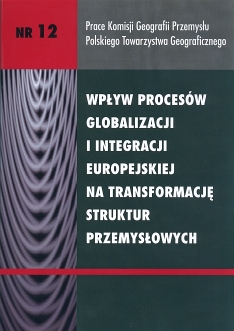Specjalne strefy ekonomiczne i strefy przemysłowe w kształtowaniu rozwoju gospodarczego regionów na przykładzie Polski i Czech
DOI:
https://doi.org/10.24917/20801653.12.11Słowa kluczowe:
SSE, regiony, rozwój gospodarczyAbstrakt
The aim of the present work is to show how the changing approach to special economic zones in Poland influenced the competitiveness of Polish regions, both on the internal and external scale. In the case of external conditioning, a comparative analysis of competitiveness of Polish regions against the Czech regions was conducted.In the examination of the internal- and external competitiveness conditions of particular Polish regions, an important element that shapes it is the existence of special economic zones. Their location positively affects the competitiveness of the given region, due to lower costs of functioning for the subjects active in the area. According to the original assumptions, creation of the zones was designed as a privilege for problem areas, e.g. characterized by high unemployment or low industrialization.Today’s solutions in this aspect considerably depart from the original assumptions of the idea of special zones, as - created when demanded by the investors - the zones include the most attractive regions. This has led to a situation when disproportion between peripheral and central areas of economic development is increasing. On the other hand, from the point of view of the state’s economic policy, Poland becomes more competitive. When observing the current inflow of crucial investments into the Central-European countries, we do not see situations typical of the 1990s and the first decade of the 21stcentury, when the most important investments were aimed at the Czech Republic or Slovakia (PeugeotCitroen-Toyota, VW, Kia or Hyundai), since the offers made by Poland to these investors usually concerned relatively unattractive locations, often peripheral, which could not compete with the areas of Prague, Bratislava, Ostrava, Trnava or Zilina.Downloads
Metrics
Bibliografia
Bagdziński S., Maik W., 1994, Determinants of regional and spatial policy in the period of system transformation, [w:] R. Domański, E. Judge, red., Changes in the regional economy in the period of system transformation, PWN, Warszawa, s. 55–69
Budzowski K., Świętowiec J., 1997, Przesłanki tworzenia i warunki funkcjonowania stref uprzywilejowanych, „Zeszyty Naukowe Akademii Ekonomicznej w Krakowie”, 501, s. 75–86
Guangwen M., 2003, The theory and practice of free economics Jones: a case study of Tianjin, People’s republic of China, Combined Faculties for the Natural Scienes and for Mathematics of Ruprecht- Karls University of Heidelberg, Germany, Ph.D. dissertation
Domański B., Gwosdz K. red., 2005, Dziesięć lat doświadczeń pierwszej polskiej specjalnej strefy ekonomicznej. Mielec 1995–2005, Instytut Geografii i Gospodarki Przestrzennej Uniwersytetu Jagiellońskiego w Krakowie, Agencja Rozwoju Przemysłu S.A. Oddział w Mielcu
Gwosdz K., Huculak M., Jarczewski W., Wiedermann K., 2005, Specjalne strefy ekonomiczne w Polsce. Założenia a praktyka, [w:] B. Domański, K. Gwosdz, red., Dziesięć lat doświadczeń pierwszej polskiej specjalnej strefy ekonomicznej, Mielec 1995–2005, Instytut Geografii i Gospodarki Przestrzennej Uniwersytetu Jagiellońskiego w Krakowie, Agencja Rozwoju Przemysłu S.A. Oddział w Mielcu
Kryńska E. red., 2000, Polskie Specjalne Strefy Ekonomiczne – zamierzenia i efekty, Europejski Instytut Rozwoju Regionalnego i Lokalnego UW, Warszawa
Kukliński A., 1991, Restrukturyzacja regionów jako problem współpracy europejskiej, [w:] A. Kukliński, B. Jałowiecki, red., Restrukturyzacja regionów jako problem współpracy europejskiej, Uniwersytet Warszawski, t. l. Studia Regionalne i Lokalne, l (34), s. 319–329
Kuliś S., 2001, Przestrzenne zróżnicowanie aktywności inwestycyjnej w specjalnych strefach ekonomicznych w Polsce, maszynopis w Instytucie Geografii i Gospodarki Przestrzennej UJ
Raport Ministerstwa Gospodarki, 2008, Informacja o realizacji ustawy o specjalnych strefach ekonomicznych – stan na 31 grudnia 2007
Rozporządzenie Rady Ministrów z dnia 13 października 2006 r. w sprawie ustalenia mapy pomocy regionalnej (Dz. U. Nr 190. poz. 1402)
Smith D.M., 1966, A theoretical framework for geographical studies of industrial location, „Economic Geography”, s. 95–113
Ustawa z dnia 20 października 1994 r. o specjalnych strefach ekonomicznych (Dz. U. Nr 123, poz. 600)
Ustawa z dnia 16 listopada 2000 r. o zmianie ustawy o specjalnych strefach ekonomicznych i zmianie niektórych ustaw (Dz. U. Nr 117, poz. 1228)
Ustawa z dnia 2 października 2003 r. o zmianie ustawy o specjalnych strefach ekonomicznych i niektórych ustaw (Dz. U. Nr 188, poz. 1840, z późn. zm.)
Ustawa z dnia 23 czerwca 2006 r. o zmianie ustawy o specjalnych strefach ekonomicznych oraz niektórych ustaw (Dz. U. Nr 141, poz. 997)
Pobrania
Opublikowane
Jak cytować
Numer
Dział
Licencja
Artykuły publikowane są zgodnie z warunkami licencji Creative Commons (CC BY-ND 4.0; uznanie autorstwa-bez utworów zależnych).

